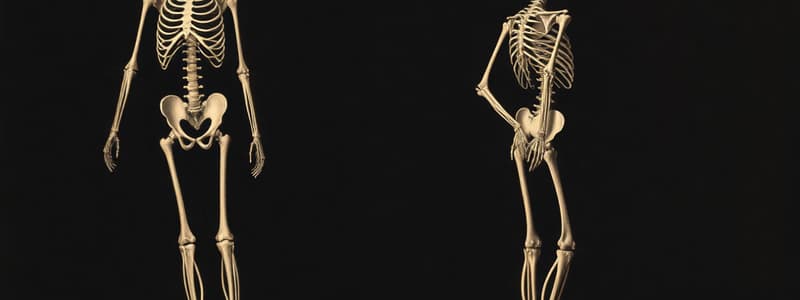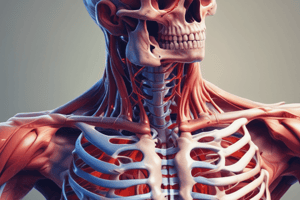Podcast
Questions and Answers
What term describes the point at which a muscle is attached that remains relatively fixed during contraction?
What term describes the point at which a muscle is attached that remains relatively fixed during contraction?
- Insertion
- Muscle belly
- Origin (correct)
- Tendon
Which muscle classification is based on the orientation of fibers?
Which muscle classification is based on the orientation of fibers?
- Circular muscles (correct)
- Smooth muscles
- Cardiac muscles
- Skeletal muscles
What happens to muscle fibers during training?
What happens to muscle fibers during training?
- The number of muscle fibers increases significantly.
- Muscle fibers decrease in size.
- Muscle fibers lose strength.
- Muscle fibers grow in size. (correct)
How do circular muscles primarily contribute to movement?
How do circular muscles primarily contribute to movement?
What is the role of the insertion point in muscle contraction?
What is the role of the insertion point in muscle contraction?
Which type of bone is characterized by a length greater than its width?
Which type of bone is characterized by a length greater than its width?
What is the primary function of ligaments within the locomotor system?
What is the primary function of ligaments within the locomotor system?
Which characteristic is unique to compact bone compared to spongy bone?
Which characteristic is unique to compact bone compared to spongy bone?
What is NOT a function of the skeletal system?
What is NOT a function of the skeletal system?
In terms of bone classification, which type has dimensions that are similar across all three axes?
In terms of bone classification, which type has dimensions that are similar across all three axes?
Which component of the bone is associated with the inner layer of connective tissue?
Which component of the bone is associated with the inner layer of connective tissue?
What type of bone classification does the carpal bone belong to?
What type of bone classification does the carpal bone belong to?
Which statement about the appendicular skeleton is true?
Which statement about the appendicular skeleton is true?
What type of joint allows for movement without a significant range, typically connected by fibrous connective tissue?
What type of joint allows for movement without a significant range, typically connected by fibrous connective tissue?
Which structure is primarily responsible for lubricating synovial joints to avoid friction?
Which structure is primarily responsible for lubricating synovial joints to avoid friction?
How do menisci differ from discs in synovial joints?
How do menisci differ from discs in synovial joints?
What are tendon sheaths primarily used for in synovial joints?
What are tendon sheaths primarily used for in synovial joints?
Which type of joint is exemplified by the union between the tooth and its socket?
Which type of joint is exemplified by the union between the tooth and its socket?
Which function is not associated with the hyaline cartilage in synovial joints?
Which function is not associated with the hyaline cartilage in synovial joints?
What is the main characteristic of synarthroses joints?
What is the main characteristic of synarthroses joints?
What are the two main layers of the synovial capsule?
What are the two main layers of the synovial capsule?
Which of the following statements about the structure of synovial joints is incorrect?
Which of the following statements about the structure of synovial joints is incorrect?
What role do fat pads play in synovial joints?
What role do fat pads play in synovial joints?
Which statement accurately describes a ball and socket joint?
Which statement accurately describes a ball and socket joint?
What type of synovial joint is characterized by having one convex and one concave articular surface?
What type of synovial joint is characterized by having one convex and one concave articular surface?
What is the primary function of ligaments in synovial joints?
What is the primary function of ligaments in synovial joints?
Fasciae have which of the following roles?
Fasciae have which of the following roles?
Which type of joint allows for angular movements and is characterized by cylindrical bone surfaces?
Which type of joint allows for angular movements and is characterized by cylindrical bone surfaces?
What type of muscle fiber connective tissue surrounds an individual muscle fiber?
What type of muscle fiber connective tissue surrounds an individual muscle fiber?
Which of the following structures allows muscles to attach to bones?
Which of the following structures allows muscles to attach to bones?
How is the superficial fascia primarily different from deep fascia?
How is the superficial fascia primarily different from deep fascia?
Muscle names related to their shape would describe which of the following examples?
Muscle names related to their shape would describe which of the following examples?
Which joint type allows for very small movements, characterized by flat bone surfaces?
Which joint type allows for very small movements, characterized by flat bone surfaces?
What is the primary function of the metaphysis in long bones?
What is the primary function of the metaphysis in long bones?
In which section of a long bone can the medullary cavity be found?
In which section of a long bone can the medullary cavity be found?
Which bony process is defined as a very large projection with a rough surface?
Which bony process is defined as a very large projection with a rough surface?
What differentiates a fossa from a groove in bone anatomy?
What differentiates a fossa from a groove in bone anatomy?
Which of the following describes a condyle?
Which of the following describes a condyle?
What function do the articular cartilages serve at the ends of long bones?
What function do the articular cartilages serve at the ends of long bones?
What best defines the term 'epicondyle'?
What best defines the term 'epicondyle'?
Which type of bone is characterized by being flattened and usually curved?
Which type of bone is characterized by being flattened and usually curved?
What is a key distinction between a tubercle and a trochanter?
What is a key distinction between a tubercle and a trochanter?
Which structure is involved in allowing passage for organs within bones?
Which structure is involved in allowing passage for organs within bones?
Flashcards are hidden until you start studying
Study Notes
Locomotor System Overview
- The locomotor system consists of the skeletal and muscular systems, facilitating body movement and stability.
- Skeletal components include bones, joints, ligaments, fasciae, and muscles.
Bones
- Bones are classified into axial (skull and trunk) and appendicular (limbs).
- Functions of bones:
- Protect vital organs (e.g., skull protects the brain).
- Allow tendon and ligament attachment, stabilizing joints.
- Define body shape and structure.
- Serve as mineral storage (calcium, phosphate).
- House red bone marrow for blood cell production.
Bone Composition
- Two types of bone tissue:
- Compact bone: Outer dense layer providing strength.
- Spongy bone: Inner trabecular structure containing bone marrow.
- Periosteum: Outer connective tissue layer; endosteum lines internal surfaces.
Bone Classification by Shape
- Long bones: Length exceeds other dimensions (e.g., femur, humerus), leverage for movement.
- Short bones: Similar dimensions, allow wider movement (e.g., carpal bones).
- Flat bones: Thin, form cavity walls (e.g., skull, ribs).
- Irregular bones: Complex shapes, multiple processes (e.g., vertebrae).
Bone Surface Features
- Bony processes: Projections such as tuberosities and trochanters indicating tendon/ligament attachment.
- Bony depressions: Features like fossae and grooves for muscle attachment or tendon passage.
- Openings: Holes for nerves and vessels (e.g., foramina).
Joints
- Classified as either:
- Synarthroses: Limited or no movement, includes fibrous (e.g., sutures) and cartilaginous (e.g., pubic symphysis) joints.
- Synovial joints: Allow varying degrees of movement, encapsulated by a synovial membrane producing lubricating fluid.
Types of Synovial Joints
- Pivot joints: Rotation around an axis (e.g., radius and ulna).
- Hinge joints: Flexion and extension (e.g., elbow).
- Saddle joints: Movements in two directions (e.g., thumb).
- Gliding joints: Sliding movements (e.g., carpal bones).
- Condyloid joints: Movements in two axes (e.g., wrist).
- Ball and socket joints: Multiaxial movement (e.g., shoulder, hip).
Ligaments
- Dense connective tissue stabilizing synovial joints, primarily composed of type I collagen.
- Function to prevent separation of bones during movement.
Fasciae
- Connective tissue creating compartments within the body, aiding posture and movement.
- Comprised of:
- Superficial fascia: Contains subcutaneous fat and provides insulation.
- Deep fascia: Surrounds muscles and facilitates functional compartmentalization.
Skeletal Muscles
- Composed of skeletal muscle fibers connected to bones via tendons.
- Functions include movement, maintaining posture, and heat production.
- Organized into layers of connective tissue:
- Endomysium: Surrounds individual muscle fibers.
- Perimysium: Surrounds bundles of fibers (fascicles).
- Epimysium: Encases the entire muscle.
- Tendons: Connective tissues merging with muscle layers; may form aponeuroses (flat structures) based on muscle type.
Muscle Naming Conventions
- Muscle names can reflect size, shape, action, number of origins, location, and points of attachment (e.g., longus, deltoid).### Muscle Naming Conventions
- Muscles are named based on function including flexors/extensors, abductors/adductors, levators/depressors, and supinators/pronators.
- Another naming method is through the number of bellies: biceps (two bellies), triceps (three bellies), quadriceps (four bellies), and digastric (two bellies with an interposed tendon).
- Positions in muscle names include anterior, posterior, medial, superficialis (superficial), and profundus (deep).
- Muscle names can also reflect the site of origin and insertion, exemplified by the sternocleidomastoid muscle which originates at the sternum and clavicle and inserts into the mastoid process.
- Fiber orientation affects muscle strength and movement direction, with circular muscles enabling the opening or closing of fissures.
Muscle Structure and Function
- Muscles attach at two main points: origin (fixed) and insertion (movable during contraction).
- Understanding both origin and insertion is crucial for comprehending muscle movements.
- The total number of muscle fibers in an individual muscle is constant throughout life.
- Muscle growth during training results from the hypertrophy of individual fibers, leading to enhanced strength and efficiency.
Studying That Suits You
Use AI to generate personalized quizzes and flashcards to suit your learning preferences.




